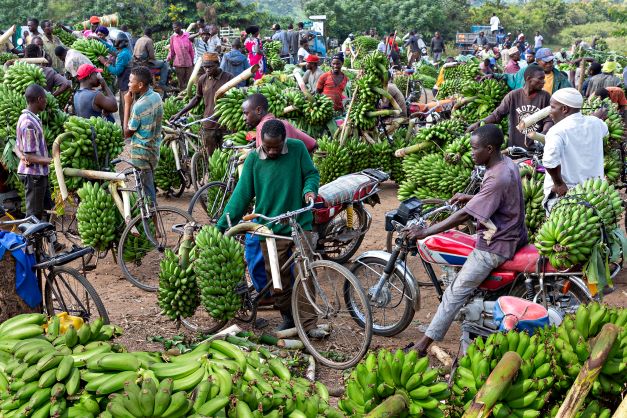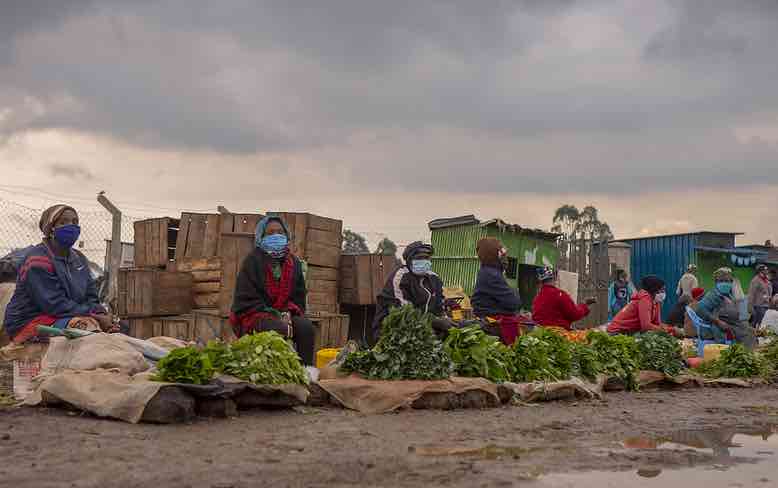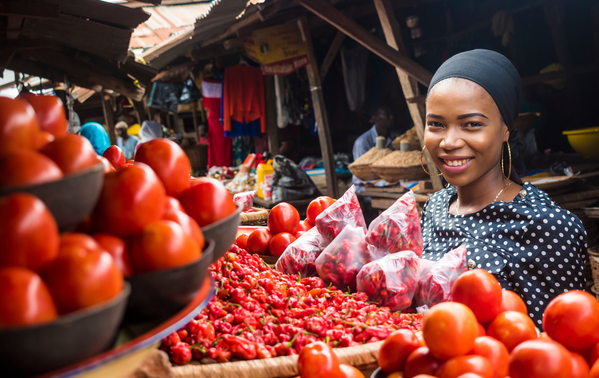IFPRI’s projects in Africa is committed to producing high quality, evidence-based outputs that contribute to agriculture development, food security, nutrition, and poverty alleviation. In particular, IFPRI’s policy research has produced technical reports, peer-reviewed journal articles, book chapters, donor reports, impact assessments, briefs, and more.
1 to
20
of 100
Journal Article
Armed conflict, community-based cash transfers, and social cohesion: Evidence from a randomized intervention in Ethiopia
2026Nigus, Halefom Yigzaw; Abay, Kibrom A.; Tabe-Ojong, Martin Paul Jr.
Journal Article
Can a light-touch graduation model enhance livelihood outcomes? Evidence from Ethiopia
2026Leight, Jessica; Gilligan, Daniel O.; Hidrobo, Melissa; Alderman, Harold; Mulford, Michael
Journal Article
The effect of teacher training and community literacy programming on teacher and student outcomes
2026Chimbutane, Feliciano; Karachiwalla, Naureen; Herrera-Almanza, Catalina; Leight, Jessica; Lauchande, Carlos
Journal Article
Agricultural technology adoption and deforestation: Evidence from a randomized control trial
2026Bloem, Jeffrey R.; Lundberg, Clark
Journal Article
The effect of using indigenous and scientific forecasts on arable farmers’ crop yields: Evidence from Rwenzori region, western Uganda
2026Nkuba, Michael Robert; Kato, Edward
Journal Article
Transfers, information and management advice: Direct effects and complementarities in Malawi
2026Ambler, Kate; de Brauw, Alan; Godlonton, Susan
Journal Article
Increasing women’s empowerment: Evaluating two interventions in Uganda
2026Ambler, Kate; Jones, Kelly M.; O’Sullivan, Michael
Journal Article
Constraints and promising interventions to strengthen fish seed systems in Sub-Saharan Africa: Evidence from Ghana
2026Ragasa, Catherine; Kruijssen, Froukje; Agyakwah, Seth Koranteng; Mensah, Emmanuel Tetteh-Doku; Asmah, Ruby; Ataa-Asantewaa, Martha; Amewu, Sena; Loison, Sarah Alobo
Journal Article
Estimating multidimensional development resilience
2026Lee, Seungmin; Abay, Kibrom A.; Barrett, Christopher B.; Hoddinott, John F.
Journal Article
How can anticipatory action programming support women? Application of the reach-benefit-empower-transform framework in Nepal and Nigeria
2026Kosec, Katrina; Kyle, Jordan; Myers, Emily; Quisumbing, Agnes R.; Gonzales, Teresa; Madero, Ana; Mittrick, Caitlin; Rapadas, Amica
Journal Article
Exposure and disease burden of fumonisins and aflatoxins from sorghum consumption in Ethiopia
2026Sadik, J.A.; Fentahun, N.; Brouwer, Inge D.; Tessema, M.; Fels-Klerx, H.J.van der
Journal Article
Vouchers to increase fruit affordability in Nigeria and Vietnam
2026Ambler, Kate; Brouwer, Inge D.; de Brauw, Alan; Herskowitz, Sylvan; Mai, Truong Tuyet; Pastori, Giulia; Samuel, Folake; Shittu, Oluyemisi; Talsma, Elise F.
Journal Article
Imperfect competition and asymmetric welfare effects of global price and productivity shocks: a CGE model analysis for Senegal
2025Zidouemba, Patrice Relouende; Traoré, Fousseini; Odjo, Sunday Pierre
Journal Article
Understanding spatial heterogeneity of hidden hunger in Senegal
2025Marivoet, Wim; Ulimwengu, John M.; Sall, Leysa Maty; Fall, Cheickh Sadibou
Journal Article
Step by step to higher yields? Adoption and impacts of a sequenced training approach for climate-smart coffee production in Uganda
2025Günther, Manuela Kristin; Bosch, Christine; Ewel, Hanna; Nawrotzki, Raphael; Kato, Edward
Brief
How can community grants promote gender-inclusive development in fragile settings? Insights from rural Nigeria
2025Kyle, Jordan; Adeyanju, Dolapo; Adida, Claire; Arriola, Leonardo; Carrillo, Lucia; Fisher, Rachel; Iraoya, Augustine Okhale; Kosec, Katrina; Matanock, Aila; Mo, Cecilia H.
Brief
Bridging the information gap: How Munda Makeover is transforming agricultural learning in Zambia
2025Owuor, Antonate Akinyi; Kramer, Berber; Ceballos, Francisco; Sambo, Kingsley
Brief
Digital tool integration, biodiversity, and the potato value chain in Kenya: Results from a baseline survey
2025Boukaka, Sedi Anne; Geoffrey, Baragu; Azzarri, Carlo
Brief
Synopsis: Quantifying food losses in the beans value chain in Rwanda – Results from a baseline survey
2025Bachewe, Fantu Nisrane; Delgado, Luciana; Niyonsingiza, Josue
Brief
Kenya: Cost effective options for inclusive and sustainable development
2025Aragie, Emerta A.; Pauw, Karl; Thurlow, James; Jones, Eleanor
Brief
From commitment to delivery: Implementation as the frontier for CAADP 3.0
2025Ingabire, Chantal; Mkandawire, Richard; Nsimadala, Elizabeth; Omamo, Steven Were; Ulimwengu, John M.
Working Paper
Malawi’s agrifood system: Transformation and environmental impacts
2025Diao, Xinshen; De Weerdt, Joachim; Fang, Peixun; Jones, Eleanor; Nagoli, Joseph; Pauw, Karl; Thurlow, James
Brief
Energy and macronutrient intake among women of reproductive age: Baseline findings from the FRESH End-to-End Evaluation
2025Bliznashka, Lilia; Azupogo, Fusta; Arnold, Charles D.; Djuazon, Nelly; Jeremiah, Kidola; Malindisa, Evangelista; Kinabo, Joyce; Cunningham, Kenda; Hess, Sonja; Olney, Deanna K.
Brief
Bridging Nigeria’s fertilizer supply-demand gap for agricultural transformation
2025Fasoranti, Adetunji; Kirui, Oliver K.; Popoola, Olufemi; Ali, Samuel; Olanrewaju, Opeyemi
Brief
Digital agricultural technology in Egypt: Insights from app developers
2025Tarek, Abdallah; Abdelhadi, Ali; Karachiwalla, Naureen
Brief
Gendered work norms in Egypt: Evidence on preferences and social perceptions
2025Allen IV, James; Gilligan, Daniel O.; Kurdi, Sikandra; Shokry, Nada; Yassa, Basma
Working Paper
The impact of genetically modified cowpea on yields, postharvest losses, and profitability in Nigeria: Findings from a cluster randomized controlled trial
2025Amare, Mulubrhan; Andam, Kwaw S.; Spielman, David J.; Bamiwuye, Temilolu; Zambrano, Patricia; Chambers, Judith A.; Fasoranti, Adetunji; Popoola, Olufemi
Brief
Micro-, small- and medium-sized enterprises and their role in sustainable healthy diets in Ethiopia
2025de Brauw, Alan; Mengesha, Belay Terefe
Brief
Mozambique: Cost effective options for inclusive and sustainable development
2025Aragie, Emerta A.; Benfica, Rui; Thurlow, James; Xu, Valencia Wenqian; Jones, Eleanor
Brief
The development potential of anchor enterprise models in Malawi
2025Benson, Todd; Cockx, Lara; De Weerdt, Joachim
Report
IFPRI Malawi maize market report, November 2025
2025International Food Policy Research Institute; Benson, Anderson
Working Paper
The landscape of youth engagement in labor markets in Africa: Are youth driving structural transformation?
2025Abay, Kibrom A.; Wondale, Meseret; Korir, Josphat K.; Bachewe, Fantu Nisrane; Araya, Mesele; Breisinger, Clemens
Journal Article
Whole maize flour could enhance food and nutrition security in Malawi
2025Ngoma, Theresa Nakoma; Taleon, Victor; Mvumi, Brighton M.; Gama, Aggrey P.; Palacios-Rojas, Natalia; Matumba, Limbikani
Journal Article
Does small-scale irrigation affect women’s time allocation? Insights from Ethiopia
2025Lee, Yeyoung; Bryan, Elizabeth; Mason, Nicole M.; Hassen, Ibrahim Worku; Theriault, Veronique; Ringler, Claudia
Journal Article
The characteristics of community seed schemes for grains and legumes: Insights from northern Nigeria
2025Takeshima, Hiroyuki; Ragasa, Catherine; Bamiwuye, Temilolu; Andam, Kwaw S.; Spielman, David J.; Omoigui, Lucky
Journal Article
Buyer-side gender discrimination in bargaining: Evidence from seed sales in Uganda
2025Van Campenhout, Bjorn; Nabwire, Leocardia
Journal Article
From data to decision: How the National Information Platform for Nutrition (NiPN) bridges the research-policy gap in Ethiopia’s nutrition sector
2025Zerfu, Taddese Alemu; Samuel, Aregash
Brief
Monitoring the impact of recent price volatility on food group consumption in Rwanda
2025Manners, Rhys; Warner, James
Brief
Synopsis: Unlocking agricultural efficiency: A stochastic frontier analysis of smallholder farmers in Rwanda
2025Benimana, Gilberthe Uwera; Warner, James; Missiame, Arnold Kwesi
Brief
Harvesting change: The impact of climate change on Africa’s agriFood systems
2025Piñeiro, Valeria; Gianatiempo, Juan Pablo; McNamara, Brian; Thomas, Timothy S.; Traoré, Fousseini
Journal Article
Rice milling and parboiling trade-offs for economic and nutritional gains with special attention to sub-Saharan Africa: A comprehensive review
2025Ndindeng, Sali Atanga; Tang, Erasmus Nchuaji; Twine, Edgar; Taleon, Victor; Frei, Michael
Working Paper
Public expenditure on agriculture, youth out-migration, and engagement in agriculture? Evidence from Nigeria
2025Amare, Mulubrhan; Takeshima, Hiroyuki; Abay, Kibrom A.; Omamo, Steven Were
Working Paper
Bridging the gap: How human-centered design can help unlock bottlenecks in the diffusion of small-scale irrigation in Nigeria
2025
…more
Ringler, Claudia
Report
Essential commodities prices, availability, and market actors’ perceptions: October 2025
2025Rakhy, Tariq; Abushama, Hala; Mohamed, Shima; Nigus, Halefom Yigzaw; Siddig, Khalid
Brief
The effects of a secondary school scholarship on youth outcomes: Evidence from a randomized trial
2025Leight, Jessica
Working Paper
Implications of increased urbanization and consumer awareness on future food supplies in Tanzania
2025Marivoet, Wim; Alphonce, Roselyne
Working Paper
Impact of conflict on key agro-industries in Khartoum State, Sudan: Wheat flour milling, oil processing, and packaging
2025Ibrahim, Ammar; Mohamed, Shima; Abdel-Karim, Mohamed; Siddig, Khalid
Working Paper
Conflict and agricultural inputs: Impacts on maize yields in Nigeria
2025Amare, Mulubrhan; Andam, Kwaw S.; Balana, Bedru; Olanrewaju, Opeyemi; Omamo, Steven Were
Brief
Multistakeholder platforms in transboundary waters: What do we know, and where should we go?
2025Lautze, Jonathan; Nehring, Ryan
Report
Statistics from Space: Next-Generation Agriculture Production Information for Enhanced Monitoring of Food Security in Mozambique – Groundtruthing data collection and stakeholder engagement report
2025Centre of Excellence in Agri-Food Systems and Nutrition
Report
Statistics from Space: Next-Generation Agriculture Production Information for Enhanced Monitoring of Food Security in Mozambique – Enumerators training report
2025Centre of Excellence in Agri-Food Systems and Nutrition
Report
IFPRI Malawi maize market report, October 2025
2025International Food Policy Research Institute; Benson, Anderson
Report
Application of an analytical framework to hindcast crop yield in major crop production regions in Mozambique
2025Kim, Kwang Soo; Hyun, Shinwoo; Lee, Seok Ho
Journal Article
Vulnerability of Nigerian maize traders to a confluence of climate, violence, disease and cost shocks
2025Vargas, Carolina M.; Liverpool-Tasie, Lenis Saweda O.; Reardon, Thomas
Dataset
Ultra-poor Graduation Midline Survey in Somalia, 2023
2025International Food Policy Research Institute
Dataset
Ultra-poor Graduation Endline Survey in Somalia, 2024
2025International Food Policy Research Institute
Working Paper
Food systems in conflict-prone and climate-affected areas of Northern Nigeria: Humanitarian and development challenges
2025Balana, Bedru; Omamo, Steven Were; Amare, Mulubrhan; Popoola, Olufemi; Nwagboso, Chibuzo; Iraoya, Augustine Okhale; Loum, Serigne; Jawed, Khusro; Andam, Kwaw S.
Working Paper
Mapping the design and implementation of seed sector regulation: The case of Rwanda
2025Kuhlmann, Katrin; Nalinya, Adron Naggayi; Spielman, David J.; Francis, Tara
Working Paper
Economywide assessment of CSA interventions in building resilient agri-food systems in Rwanda
2025Aragie, Emerta A.; Thurlow, James; Warner, James; Niyonsingiza, Josue
Working Paper
The changing demographics in Nigeria’s food systems and implications for future youth engagement
2025Bachewe, Fantu Nisrane; Andam, Kwaw S.; Mawia, Harriet; Popoola, Olufemi
Journal Article
Impact of conflict shocks on land rental market dynamics: Panel evidence from Nigeria
2025Olanrewaju, Opeyemi; Bamiwuye, Temilolu; Omotayo, Abiodun Olusola
Journal Article
Food price stabilization: Theory and lessons from experience
2025Dorosh, Paul A.; Minot, Nicholas; Rashid, Shahidur
Working Paper
Armed conflict, community-based cash transfers, and social cohesion: Evidence from a randomized intervention in Ethiopia
2025Abay, Kibrom A.; Nigus, Halefom Yigzaw; Tabe-Ojong, Martin Paul Jr.
Journal Article
Aggregation models in agricultural value chains of staple crops and their potential application for biofortification: A scoping review
2025Parikh, Panam; Aparo, Nathaline Onek; de Barcellos, Marcia D.; Nyangaresi, Annette M.; Gorla, Ishank M.; Mudyahoto, Bho; Friesen, Valerie M.; De Steur, Hans
Journal Article
The linkages between water supply, sanitation and hygiene and small-scale irrigation: Insights from rural Ethiopia
2025Bryan, Elizabeth; van Biljon, Chloé; Lee, Yeyoung; Ringler, Claudia; Mekonnen, Dawit Kelemework
Journal Article
Neonatal mortality risk of vulnerable newborns by fine stratum of gestational age and birthweight for 230 679 live births in nine low- and middle-income countries, 2000-2017
2025
…more
Baqui, Abdullah H.; Saha, Samir K.; Ahmed, Salahuddin; Roy, Arunangshu Dutta; Silveira, Mariângela F.; Buffarini, Romina; Shapiro, Roger; Zash, Rebecca; Kolsteren, Patrick; Lachat, Carl; Huybregts, Lieven; Roberfroid, Dominique; Zhu, Zhonghai; Zeng, Lingxia; Gebreyesus, Seifu H.; Tesfamariam, Kokeb; Adu-Afarwuah, Seth; Dewey, Kathryn G.; Gyaase, Stephaney; Poku-Asante, Kwaku; Boamah Kaali, Ellen; Jack, Darby; Ravilla, Thulasiraj; Tielsch, James; Taneja, Sunita; Chowdhury, Ranadip; Ashorn, Per; Maleta, Kenneth; Ashorn, Ulla; Mangani, Charles; Mullany, Luke C.; Khatry, Subarna K.; Ramokolo, Vundli; Zembe-Mkabile, Wanga; Fawzi, Wafaie W.; Wang, Dongqing; Schmiegelow, Christentze; Minja, Daniel; Msemo, Omari Abdul; Lusingu, John P. A.; Smith, Emily R.; Masanja, Honorati; Mongkolchati, Aroonsri; Keentupthai, Paniya; Kakuru, Abel; Kajubi, Richard; Semrau, Katherine; Hamer, Davidson H.; Manasyan, Albert; Pry, Jake M.; Chasekwa, Bernard; Humphrey, Jean; Black, Robert E.
Journal Article
Impact of production-and consumption-oriented interventions on crop varietal adoption: Cluster-randomized controlled trial evidence from northern Nigeria
2025Ragasa, Catherine; Oyinbo, Oyakhilomen; Ma, Ning
Journal Article
Aflatoxin contamination of maize flour in Kenya: Results from multi-city, multi-round surveillance
2025Hoffmann, Vivian; Ndisio, Boaz; Barasa, Allan; Okoth, Sheila; Murphy, Mike
Journal Article
Effect of azithromycin on post-discharge growth in Kenyan children
2025
…more
Bogonko, George; Nduati, Ruth; Richardson, Barbra A; John-Stewart, Grace; Walson, Judd L; Singa, Benson O; Pavlinac, Patricia B; McGrath, Christine J
Brief
Spatial analysis shows moderate yet significantly more vigorous crops in AICCRA communities compared to control communities
2025Song, Chun; Kramer, Berber; Obeng, Faustina; Chepsiror, Calvin; Dalaa, Mustapha; Mahama, Obed; Berti, Lorenzo; Assefa, Thomas; Nowak, Andreea C.; Tepa-Yotto, Ghislian
Working Paper
Overcoming budget constraints to healthy diets: Evidence from urban Tanzania
2025Manda, Constantine; Sango, Danford; Hoffmann, Vivian; de Brauw, Alan; Zakaria, Zakayo; Temba, George; Brown, Elizabeth; Richards, Dorothy; Rashid, Said
Working Paper
Rebuilding trust in local leadership in conflict-affected settings: The impact of community-based cash transfers
2025Abay, Kibrom A.; Nigus, Halefom Yigzaw; Kahsay, Goytom Abraha; Taffesse, Alemayehu Seyoum
Working Paper
The price of fragility: Shocks, food security, and lessons from Nigeria
2025Amare, Mulubrhan; Omamo, Steven Were; Balana, Bedru; Andam, Kwaw S.; Nwagboso, Chibuzo; Iraoya, Augustine; Popoola, Olufemi; Loum, Serigne; Jawed, Khusro
Working Paper
Digital tool integration, biodiversity, and the potato value chain in Kenya: Results from a baseline survey
2025Boukaka, Sedi Anne; Geoffrey, Baragu; Azzarri, Carlo
Working Paper
Signaling, screening, or sunk costs? Experimental evidence on how prices affect agricultural technology adoption in East Africa
2025Van Campenhout, Bjorn; Abate, Gashaw T.; Colen, Liesbeth; Kramer, Berber
Report
Africa Report: External development financial flows to food systems
2025Gbossa, Nadine; Yamdjeu, Augustin Wambo; Ulimwengu, John M.
Working Paper
Healthy diets and the role of micro, small, and medium enterprises: Examining Ethiopia’s food environment
2025de Brauw, Alan; Hirvonen, Kalle
Report
Essential commodities prices, availability, and market actors’ perceptions: September 2025
2025Siddig, Khalid; Rakhy, Tarig; Abushama, Hala; Mohamed, Shima; Nigus, Halefom Yigzaw
Brief
Malawi: Cost effective options for inclusive and sustainable development
2025Aragie, Emerta A.; Kankwamba, Henry; Pauw, Karl; Thurlow, James; Jones, Eleanor
Brief
Investing in innovative food systems solutions in challenging contexts
2025World Food Programme; African Development Bank; International Food Policy Research Institute
Dataset
Food Security Simulator – Malawi
2025International Food Policy Research Institute
Report
IFPRI Malawi Monthly Maize Market Report, September 2025
2025International Food Policy Research Institute; Benson, Anderson
Working Paper
Graduating from Ethiopia’s Productive Safety Net Programme: What have we learned?
2025Hirvonen, Kalle; Abate, Gashaw T.; Berhane, Guush; Gilligan, Daniel O.; Hidrobo, Melissa; Hoddinott, John F.; Leight, Jessica; Taffesse, Alemayehu Seyoum
Report
Investing in innovative food systems solutions in challenging contexts: A food supply chain mapping and analysis
2025World Food Programme; International Food Policy Research Institute; African Development Bank
Brief
Senegal assessment [of the PEDAL project]
2025Resnick, Danielle; Diatta, Ampa Dogui
Working Paper
Are poor people conditionally cooperative? Contrasting evidence from a field-adapted contributions game
2025Allen IV, James; Karachiwalla, Naureen; Rakshit, Deboleena
Report
Essential commodities prices, availability, and market actors’ perceptions: August 2025
2025Siddig, Khalid; Rakhy, Tarig; Abushama, Hala; Mohamed, Shima; Nigus, Halefom Yigzaw
Opinion Piece
Beyond the human touch: Can generative AI transform Uganda’s agricultural extension and advisory services?
2025Asiimwe, Elizabeth; Davis, Kristin E.
Journal Article
Simulated impact of vitamin A-fortified sugar on dietary adequacy and association of usual sugar intake with plasma and breast milk retinol among lactating Zambian women
2025
…more
Palmer, Amanda C.
Opinion Piece
Heavy on plans, light on delivery: The structural failures of Ethiopia’s nutrition policies
2025Zerfu, Taddese Alemu
Brief
Addressing data deficiency in CAADP’s poverty reduction commitment
2025Ulimwengu, John M.; Tefera, Wondwosen
Journal Article
Miracle seeds: Biased expectations, complementary input use, and the dynamics of smallholder technology adoption
2025Miehe, Caroline; Nabwire, Leocardia; Sparrow, Robert; Spielman, David J.; Van Campenhout, Bjorn
Journal Article
Zinc distribution in structural components of high kernel‑zinc maize and its retention after milling
2025Taleon, Victor; Palacios-Rojas, Natalia; Dollah, Yusuf; Rosales, Aldo; Kalejaiye, Olatundun; Menkir, Abebe
Report
Sidama Coffee Agronomy Program: Impact report
2025Abate, Gashaw T.; Regassa, Mekdim D.; Bernard, Tanguy; Minten, Bart
Journal Article
Exploring the barriers and facilitators of nutrition and dietary intake among school-aged children in the urban low-income setting of Addis Ababa
2025Adugna, Yimer Mihretie; Ayelign, Abebe; Zerfu, Taddese Alemu
Journal Article
Beyond the bids: Lessons from farmers’ reflections on Vickrey auctions of sweetpotato vines in Rwanda
2025Kilwinger, Fleur B.M.; Spielman, David J.; Almekinders, Conny J.M.; Rajendran, Srinivasulu; van Dam, Ynte K.
Journal Article
Policy and regulation in seed sector development for vegetatively propagated crops: Insights from Kenya, Nigeria, and Vietnam
2025Spielman, David J.; Gatto, Marcel; Wossen, Tesfamicheal; McEwan, Margaret; Abdoulaye, Tahirou; Maredia, Mywish K.; Hareau, Guy
Working Paper
Impact of armed conflict on crop production in greater Khartoum, Sudan
2025Sidahmed, Anwar; Mohamed, Shima
Journal Article
Looks matter? Field performance and farmers’ preferences for drought-tolerant maize in Kenya
2025Kramer, Berber; Wellenstein, Hailey; Waweru, Carol; Kivuva, Benjamin
Journal Article
Economy-wide implications of increasing school enrolment in Sub-Saharan Africa
2025Elnour, Zuhal; Siddig, Khalid; Grethe, Harald
1 to
20
of 100



